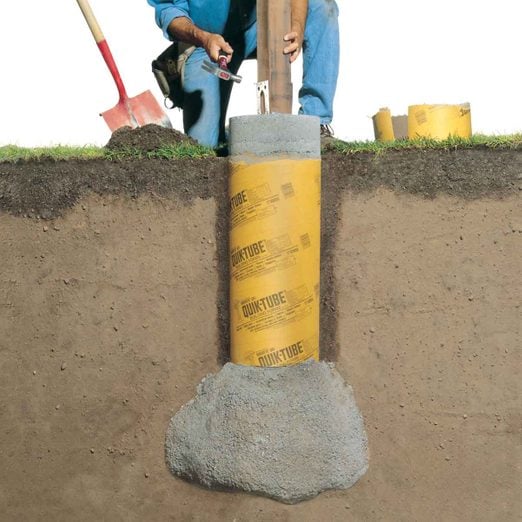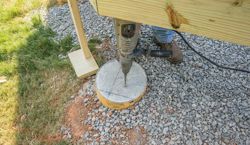Engineered for Success: The Science Behind Durable and Resilient Deck Footings
Engineered for Success: The Science Behind Durable and Resilient Deck Footings
Blog Article
Choosing the Right Deck Footings for Stability and Durability
The longevity and security of your deck depend greatly on the type of footings you pick, as they offer the essential assistance and stability to stand up to the examination of time. In this discussion, we will certainly check out the numerous types of deck footings, take into consideration the essential factors to evaluate when making a decision, and dive right into the pros and cons of various options.
Kinds Of Deck Grounds
These footings consist of a round hole filled up with concrete, which offers a strong foundation for the deck posts. Concrete pier grounds are relatively simple to mount and offer outstanding stability, making them a preferred selection for several deck projects.
An additional kind of ground is the helical pile footing. Helical stacks are steel shafts with helical plates affixed to them. These grounds are set up by screwing them right into the ground, which produces a safe and secure structure for the deck. Helical heap footings are perfect for locations with tough soil conditions, as they can be set up in almost any type of sort of dirt. If needed., they also enable for easy adjustment and leveling of the deck.
Alternatively, some builders go with precast concrete grounds. These grounds are made of resilient concrete and can be found in different sizes and shapes to fit different deck styles. Precast concrete grounds are hassle-free to mount and supply a steady base for the deck framework.
Lastly, one more option is the post-in-anchor footing system. This kind of ground includes driving a metal support right into the ground and connecting it to the deck article. It offers versatility in terms of positioning the deck blog posts and appropriates for decks with lightweight frameworks.
When picking the appropriate type of deck footing, it is important to think about elements such as dirt conditions, deck lots, and regional building regulations (Deck Footings). Consulting with a specialist service provider or architectural engineer can aid ensure the suitable ground is picked for a secure and steady deck
Aspects to Think About When Choosing Grounds
When picking the suitable grounds for a deck, it is crucial to carefully take into consideration various variables such as dirt problems, deck lots, and adherence to regional building ordinance. These factors play a significant role in making sure the stability and resilience of the deck framework.
One of the main elements to take into consideration is the dirt conditions. The kind of dirt on which the deck will certainly be constructed establishes the kind of footings needed. Decks constructed on sandy or loosened soils may call for deeper footings to supply appropriate support and stop settling. On the various other hand, decks improved clay or extensive dirts might require grounds that can accommodate the dirt's propensity to increase and agreement.
One more vital element is the deck tons. The weight of the deck, consisting of the materials utilized and any type of potential online lots such as furniture or events, must be taken right into account when choosing grounds. The grounds need to be created to bear the weight of the deck and disperse it uniformly to avoid any structural issues or failures.
Lastly, adherence to neighborhood structure codes is critical. Building regulations vary from region to region, and it is necessary to adhere to the specific needs set by the regional authorities. Deck Footings. These codes guarantee that the deck is developed securely and meets the necessary criteria for structural stability and load-bearing ability
Concrete Footings: Cons and pros

Concrete grounds provide a number of benefits and negative aspects when made use of as the foundation for a deck. On the silver lining, concrete footings provide exceptional security and sturdiness. Concrete is a stiff and solid material that can support hefty loads and hold up against numerous weather. It likewise has a long lifespan, making it a dependable selection for long-term use.
An additional advantage of concrete footings is their convenience. They can be put into various shapes and dimensions to suit various deck layouts and setups. Concrete footings can be customized to fit the specific demands and requirements of the deck framework.
Nonetheless, there are additionally some disadvantages to making use of concrete footings. This can increase the general price of the deck project and might need expert assistance.

Helical Piers Vs. Sonotubes: Which Is Better?
In taking into consideration the structure alternatives for a deck, the contrast in between helical piers and sonotubes is vital in establishing the premium option. They are twisted into the ground using hydraulic machinery, providing a stable and sturdy structure for the deck.
When it concerns stability and resilience, helical piers have the upper hand. The helical plates on the piers develop a solid hold with the soil, avoiding any movement or changing of the deck. This is specifically helpful in areas with unstable or changing soil conditions. Sonotubes, on this link the various other hand, depend solely on the concrete loading for stability, which may not supply the exact same level of toughness and resistance.
In regards to installation, helical piers are relatively easier and faster to set up contrasted to sonotubes. The hydraulic machinery made use of to twist the piers into the ground ensures a efficient and fast procedure. Sonotubes, on the other hand, call for excavating holes and putting concrete, which can be labor-intensive and lengthy.
Additionally, helical piers are a more functional option. They can be utilized in numerous soil conditions and can be readjusted or reinforced if required. Sonotubes, on the other hand, might require extra support, such as rebar, in particular dirt conditions or locations with high load demands.
Selecting the Right Footings for Your Deck's Measurements
For ideal structural honesty, it is necessary to very carefully select the proper footings that align with the measurements of your deck. The dimensions of your deck, check these guys out including its height, length, and size, play a significant function in establishing the type and dimension of grounds called for.
When picking grounds for your deck, it is necessary to think about the load-bearing capability of the soil. The weight of the deck, incorporated with the weight of any kind of furnishings or people on it, applies a significant force on the footings (Deck Footings). It is important to pick footings that can sufficiently support this weight without sinking or changing over time.
The shapes and size of the footings ought to additionally be considered. Larger decks with greater dimensions require larger grounds to give adequate stability and support. The form of the grounds, whether they are useful content square or rounded, depends upon the design and layout of the deck. In addition, the deepness at which the footings are installed ought to be figured out based on the frost line in your area to stop any kind of heaving or changing as a result of freezing temperature levels.
Verdict
In final thought, picking the right deck grounds is essential for making certain security and sturdiness. Factors such as the kind of footings, the deck's measurements, and the pros and cons of various options need to be thought about.
These grounds consist of a round hole loaded with concrete, which provides a strong structure for the deck blog posts. Concrete pier grounds are reasonably simple to install and offer exceptional stability, making them a preferred option for several deck projects.
Precast concrete grounds are hassle-free to mount and supply a steady base for the deck structure.
It supplies adaptability in terms of positioning the deck posts and is appropriate for decks with lightweight frameworks.
Concrete grounds offer several advantages and downsides when used as the foundation for a deck.
Report this page